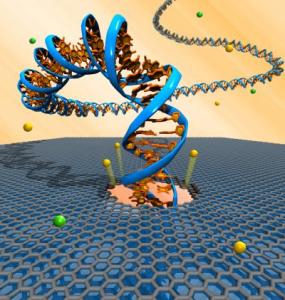Jul 27 2010
Researchers at the University of Pennsylvania have developed a new, carbon-based nanoscale platform to electrically detect single DNA molecules.
Using electric fields, the tiny DNA strands are pushed through nanoscale-sized, atomically thin pores in a graphene nanopore platform that ultimately may be important for fast electronic sequencing of the four chemical bases of DNA based on their unique electrical signature.
The pores, burned into graphene membranes using electron beam technology, provide Penn physicists with electronic measurements of the translocation of DNA.
The article, submitted on March 25, is published in the current issue of Nano Letters.
 University of Pennsylvania researchers developed a carbon-based, nanoscale platform to electrically detect single DNA molecules.
University of Pennsylvania researchers developed a carbon-based, nanoscale platform to electrically detect single DNA molecules.
"We were motivated to exploit the unique properties of graphene — a two-dimensional sheet of carbon atoms — in order to develop a new nanopore electrical platform that could exhibit high resolution," said Marija Drndiæ, associate professor in the Department of Physics and Astronomy in Penn's School of Arts and Sciences and the paper's senior author. "High resolution of graphene nanopore devices is expected because the thickness of the graphene sheet is smaller than the distance between two DNA bases. Graphene has previously been used for other electrical and mechanical devices, but up until now it has not been used for DNA translocation."
The research team had made graphene nanopores in a study completed two years ago and in this study put the pores to work.
To conduct the experiments, Drndiæ and postdoctoral fellow Christopher A. Merchant, together with Ken Healy, Meni Wanunu, Vishva Ray and other members from the Drndiæ lab made use of large-area graphene material developed by postdoctoral fellow Zhengtang Luo and Professor A.T. Charlie Johnson, both physicists at Penn. The team used a chemical vapor deposition, or CVD, method to grow large flakes of graphene and suspend them over a single micron-sized hole made in silicon nitride. An even smaller hole, the nanopore in the very center of the suspended graphene, was then drilled with an electron beam of a transmission electron microscope, or TEM.
Solid-state nanopores are proving to be invaluable tools for probing biology at the single-molecule level.
Graphene nanopore devices developed by the Penn team work in a simple manner. The pore divides two chambers of electrolyte solution and researchers apply voltage, which drives ions through the pores. Ion transport is measured as a current flowing from the voltage source. DNA molecules, inserted into the electrolyte, can be driven single file through such nanopores.
As the molecules translocate, they block the flow of ions and are detected as a drop in the measured current. Because the four DNA bases block the current differently, graphene nanopores with sub-nanometer thickness may provide a way to distinguish among bases, realizing a low-cost, high-throughput DNA sequencing technique.
In addition, to increase the robustness of graphene nanopore devices, Penn researchers also deposited an ultrathin layer, only a few atomic layers thick, of titanium oxide on the membrane which further generated a cleaner, more easily wettable surface that allows the DNA to go through it more easily. Although graphene-only nanopores can be used for translocating DNA, coating the graphene membranes with a layer of oxide consistently reduced the nanopore noise level and at the same time improved the robustness of the device.
Because of the ultrathin nature of the graphene pores, researchers were able to detect an increase in the magnitude of the translocation signals relative to previous solid state nanopores made in silicon nitride, for similar applied voltages.
The Penn team is now working on improving the overall reliability of these devices and on utilizing the conductivity of the graphene sheet to create devices with transverse electrical control over DNA transport. Specifically, this transverse electrical control may be achievable by carving graphene into nanoelectrodes and utilizing its conducting nature. Towards this goal, Michael Fischbein and Drndic have previously demonstrated nanosculpting of graphene into arbitrary structures, such as nanoribbons, nanopores and other shapes, published in Applied Physics Letters in 2008, creating a firm foundation for future research.
Source: http://www.upenn.edu/